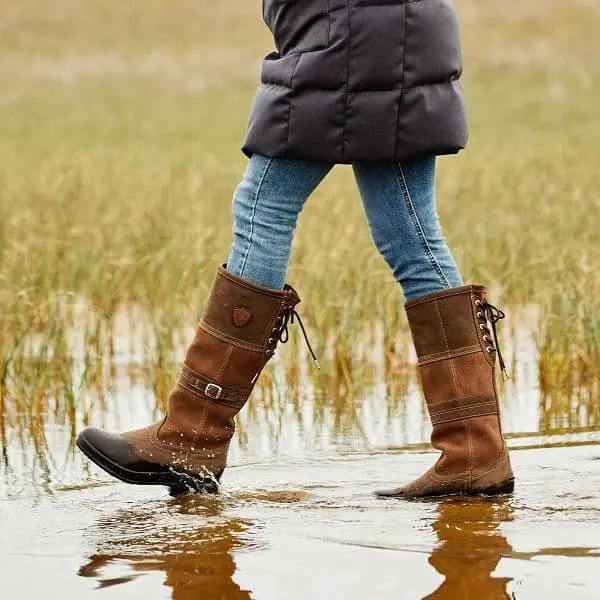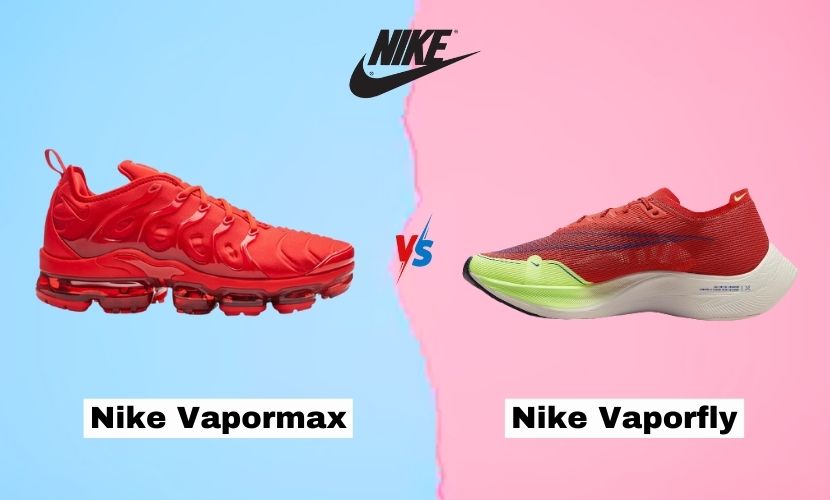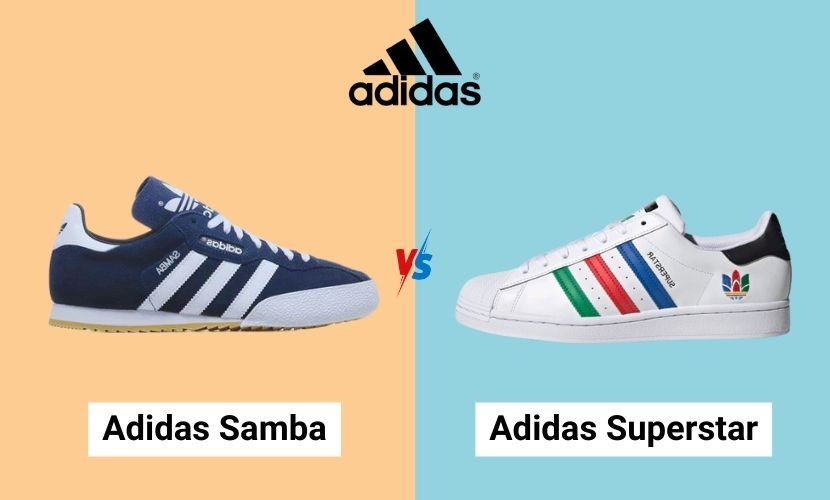Trail running is a famous outdoor activity that needs the perfect gear to provide a snug and secure experience. A dependable pair of shoes is one of the obligatory pieces of equipment for trail athletes. Hoka, a renowned brand in the running community, features two popular designs for trail players: the Speedgoat and the Challenger.
The Hoka Speedgoat and Challenger are structured to offer comfort, steadiness, and grip on rugged terrain. However, trail athletes should contemplate several major differences between the two models when selecting between them. The Speedgoat is popular for its aggressive outsole; conversely, the Challenger is more delicate and has a moderately aggressive rocker.
Furthermore, the Speedgoat provides a Vibram Megagrip with a Traction Lug; on the contrary, the Challenger contains a proprietary outsole rubber. These dissimilarities can influence a player’s performance and experience on the trail.
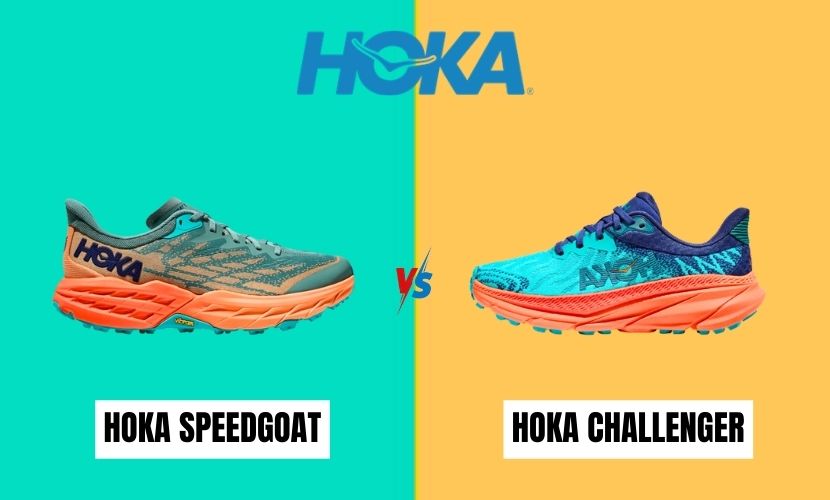
Feature Table: Hoka Speedgoat Vs Hoka Challenger
| Feature | Hoka Speedgoat | Hoka Challenger |
| Traction and Grip | Vibram Megagrip outsole | Proprietary outsole rubber |
| Weight | Moderately heavy | Lightweight |
| Cushioning | More padding | Less padding |
| Terrain Preference | Technical terrain | Sustained trails and surfaces |
| Breathability | Less absorbent | More absorbent |
| Fit | Broad toe box | Snug fit |
| Price | Typically higher cost | Slightly lower cost |
Overview of Hoka Speedgoat
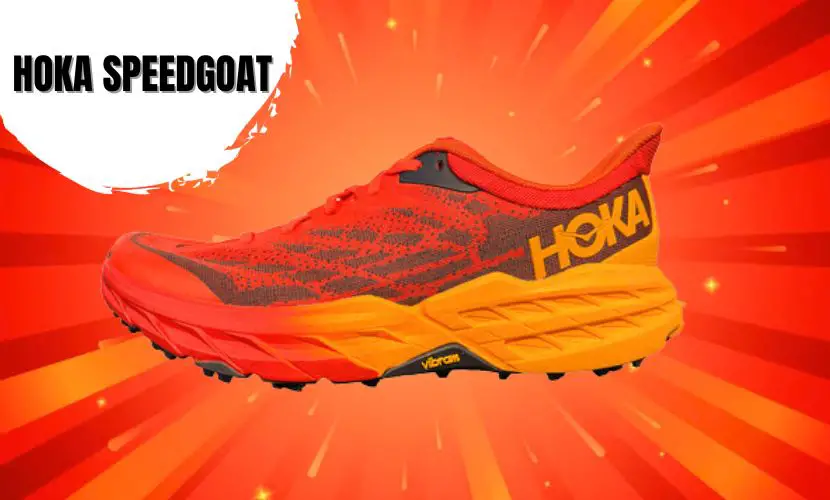
Hoka Speedgoat is a trail running shoe engineered to give remarkable grip, padding, and durability on rugged terrain. It is named after Karl “Speedgoat” Meltzer, an ultra-athlete who has won many races and set records using Hoka shoes.
The Speedgoat provides a Vibram Megagrip outsole with 5mm lugs offering remarkable traction on damp, dry surfaces and loose, stony terrain. The midsole is designed with CMEVA foam, which features an ideal balance of padding and reactiveness.
The upper of the Speedgoat is structured of an absorbent netting material with fortified overlays in exclusive areas. It also comprises a gusseted tongue that helps in maintaining debris out of the shoe. The shoe contains a 4mm heel-to-toe drop, which gives a more innate foot strike and helps minimize the possibility of injury.
The Hoka Speedgoat is a versatile trail running shoe that can control various terrain. It is a famous option among ultra-runners and has attained positive reviews for its comfort, longevity, and performance.
Overview of Hoka Challenger
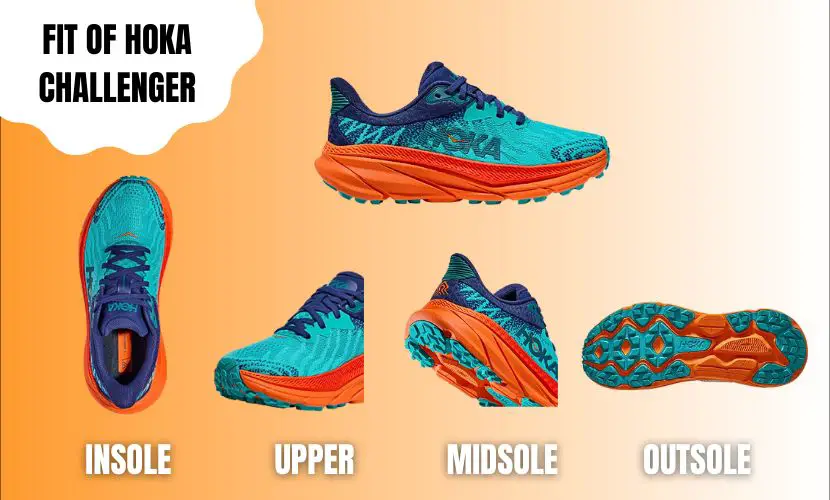
The Hoka Challenger is a renowned trail running shoe with a delicate and snug pattern. It is a perfect choice for players searching for a shoe that can handle diverse terrains.
The shoe offers an absorbent upper made of netting material that helps to keep the feet cool, fresh and dry during long runs. The tongue pad gives extraordinary ease and support; however, the lacing system permits a safe and personalized fit.
Regarding performance, the Hoka Challenger performs perfectly on maintained trails and man-constructed surfaces. It comprises a delicate design that permits faster runs, and the tread gives a good grip on these surfaces.
However, the shoe may be better for runners encountering steep, rugged, and loose terrain. The outsole provides less traction than some other trail running shoes, just as the Hoka Speedgoat.
Overall, the Hoka Challenger is a firm choice for runners who desire a feathery, snug shoe for running on sustained trails and manufactured grounds.
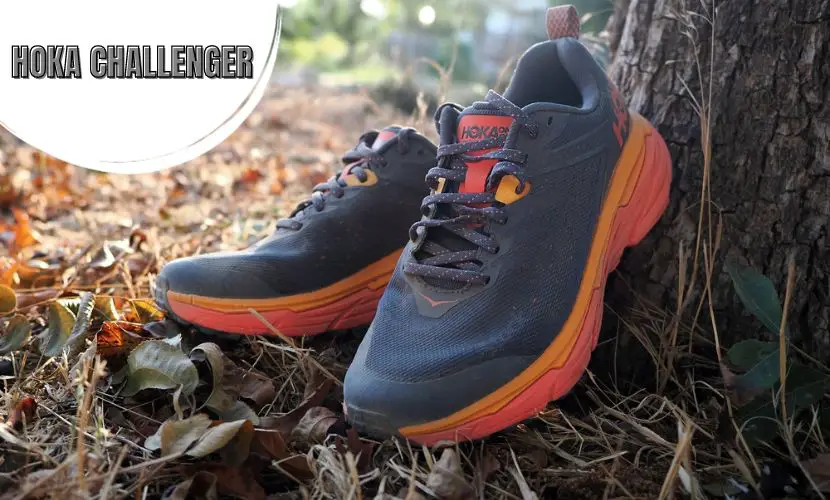
Design Comparison
Regarding design, both the Hoka Speedgoat and Challenger contain versatile features.
The Hoka Speedgoat contains a streamlined design that is ideal for trail running. It comprises a porous netting upper fortified with 3D-printed overlays for durability. The shoe’s gusseted tongue maintains debris out, and the midfoot cage features support and steadiness. The shoe also contains a Vibram Megagrip outsole, which verifies optimal grip on damp and dry surfaces.
On the other hand, the Hoka Challenger contains a more customary pattern. It comprises a lightweight and absorbent mesh upper that gives ease and ventilation. The shoe’s toe box is fortified with a rubber cap to shield against rocks and debris. The shoe also has a cushioned tongue that gives extra padding and comfort. The Challenger’s outsole is designed of a hard-wearing rubber compound with remarkable grip on distinct surfaces.
In the case of weight, the Hoka Challenger is more delicate than the Speedgoat, making it a perfect choice for runners who prioritize a more unembellished shoe. The Challenger also has a deeper heel-to-toe drop, with a more innate running experience.
The Speedgoat’s slender pattern and Vibram Megagrip outsole make it an outstanding option for technical trail running. Conversely, the Challenger’s feathery and permeable design makes it a perfect choice for athletes who prefer ease and speed.
Material Comparison
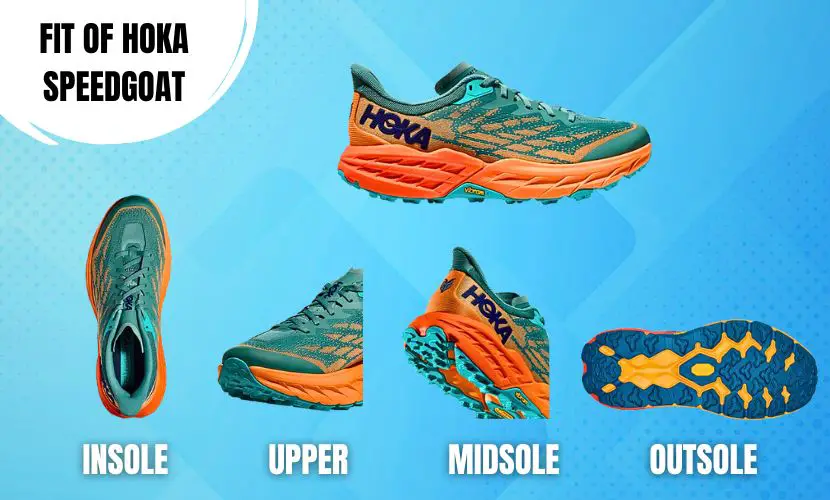
When contrasting the Hoka Speedgoat and Challenger, it is necessary to take a deeper look at the materials utilized in every shoe. Following is a breakdown of the major material dissimilarities between the two designs:
Insole
The insole of the Speedgoat is moderately more massive than that of the Challenger, giving extraordinary padding and support. The Speedgoat’s insole is structured of OrthoLite foam, which is popular for its longevity and moisture-wicking characteristics. The Challenger’s insole is structured of EVA foam, which is also hard-wearing but less moisture-wicking than OrthoLite.
Midsole
Both the Speedgoat and Challenger provide Hoka’s signature midsole technology, which is constructed to offer additional padding and support while remaining delicate.
However, the Speedgoat’s midsole is slightly thicker than the Challenger, which features a more opulent feel underfoot. The Speedgoat’s midsole is constructed of CMEVA foam, while the Challenger’s midsole is designed of a moderately mushier EVA foam.
Outsole
The outsole of the Speedgoat is engineered for additional traction on a diversity of surfaces, incorporating loose dirt, rocks, and mud. It provides Vibram Megagrip with a Traction Lug, which is popular for its durability and traction.
The Challenger’s outsole is also structured for grip, but it is more friendly than the Speedgoat’s. It provides a proprietary rubber compound with good traction on maintained trails and man-structured surfaces.
Upper
The upper of the Speedgoat is constructed of a hard-wearing netting material structured to offer permeability and support. It also gives fortified overlays in exclusive areas for additional durability.
The Challenger’s upper is structured of a similar mesh component, but it is moderately less hard-wearing than the Speedgoat’s. It also offers fortified overlays in high-wear parts, less considerable than those on the Speedgoat.
Overall, the Speedgoat and Challenger are designed of top-quality materials that are constructed to offer maximum comfort, aid, and durability. However, the Speedgoat’s massive midsole and more combative outsole make it a finer option for runners who require extra padding and grip on technical terrain. The Challenger’s delicate weight and more permeable upper make it a superior option for runners who prefer speed and legerity over padding and aid.
Performance Analysis
Concerning performance, both the Hoka Speedgoat and Challenger contain their advantages and disadvantages. The following are several major factors to contemplate:
Traction
The Speedgoat is popular for its excellent grip on technical terrain, thanks to its Vibram Megagrip outsole. The Challenger also contains perfect traction, but its proprietary rubber outsole is less adhesive or hard-wearing than the Speedgoat’s.
If you’re eager to run or hike on steep, rocky trails, the Speedgoat may be the finer option.
Cushioning
Both shoes contain adequate padding, but the Speedgoat has a moderately massive midsole and a more hostile heel-to-toe drop. This can make it feel more sturdy and adaptive on long descents but may be less snug for several runners.
The Challenger contains a moderately mushier ride and maybe a superior option if you’re searching for a more padded feel.
Fit
Both shoes comprise a broad toe box and a comfortable, supportive fit. However, several athletes have mentioned that the Speedgoat can feel tight in the midfoot; however, the Challenger may feel a bit spacious overall.
Testing both shoes and detecting which feels more snug and safe on your foot is necessary.
Weight
The Speedgoat is slightly more feathery than the Challenger, which may make it a superior option for athletes who prefer speed and legerity.
However, the dissimilarity in weight is minimal, so this may not be a determining factor for everyone.
Price
The Speedgoat is typically more costly than the Challenger, which may be a contemplation for budget-conscious athletes. However, both shoes feature remarkable value for their respective cost points, and the selection may eventually depend on individual preference and intended use.
Overall, the Hoka Speedgoat and Challenger are remarkable trail running shoes that amalgamate traction, padding, and support.
Comfort and Fit
When it comes to comfort and fit, the HOKA Speedgoat and Challenger contain several differences that players should consider before hitting the jackpot.
The HOKA Speedgoat 5 contains a broader toe box than the Challenger, permitting more space for the toes to splay. This can benefit runners with extensive feet or those prioritizing an ample fit. The Speedgoat also comprises a moderately cushioned tongue and collar, giving additional padding and support around the ankle.
On the other side, the HOKA Challenger 7 has a more comfortable and safe fit, thanks to its upgraded upper pattern. It also has a moderately mushier and more stretchable upper material, offering a more snug fit for runners prioritizing a squishier feel. The Challenger also comprise a more slender pattern, making it a delicate and faster choice for runners who prefer speed.
Both shoes contain a similar midsole stack height and padding level so players can anticipate a similar standard of comfort and aid from both choices. However, the Speedgoat has a moderately more combative outsole with lower lugs, featuring finer grip on technical terrain.
Durability Assessment
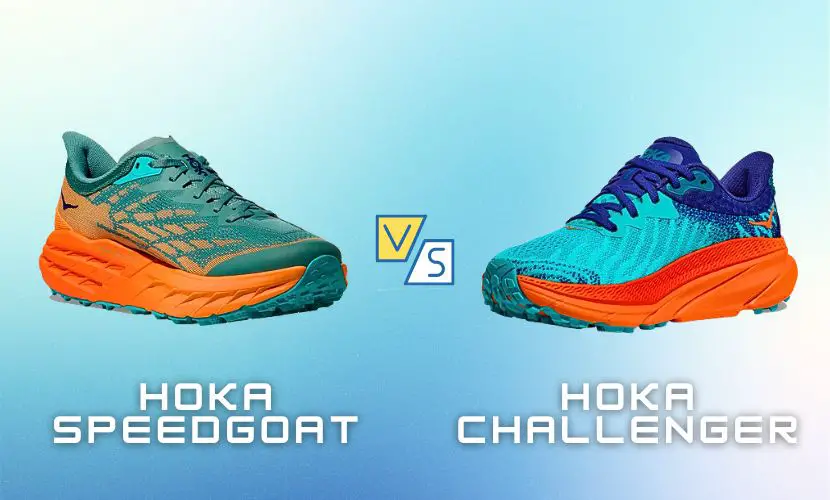
Concerning trail running shoes, durability is a critical point to consider. Both the Hoka Speedgoat and Challenger models are structured to resist the rigors of off-road running, but how do they compare in terms of durability?
Initially, both shoes are engineered with top-quality materials constructed to last. The Speedgoat offers a hard-wearing Vibram outsole that gives excellent grip on various surfaces; on the other hand, the Challenger boasts a stable rubber outsole with a similar grip.
In upper construction, the Speedgoat uses reinforced netting that is structured to resist erosion and wear, while the Challenger offers feathery and permeable netting that is also durable. Both shoes also contain fortified overlays in exclusive areas to intensify durability further.
Regarding midsole durability, both shoes provide Hoka’s signature padding technology that gives remarkable impact absorption and energy backup. However, the Speedgoat has a moderately thicker midsole that may feature greater durability over time.
Overall, both the Hoka Speedgoat and Challenger models are greatly hard-wearing and built to resist the demands of trail running. However, if durability is a major priority, the Speedgoat may be the finer option because of its massive midsole and fortified mesh upper.
Price Comparison
Regarding pricing, the HOKA Speedgoat and Challenger contain the same cost points. The HOKA Speedgoat 5 typically retails for around $145; however, the HOKA Challenger 7 costs at $130. However, costs may differ based on the retailer and ongoing advertisements or discounts.
While the HOKA Speedgoat is moderately more costly than the Challenger, it features more padding and support, making it a perfect option for runners who require additional protection on the trails. Conversely, the HOKA Challenger is more delicate in weight and porous, making it a finer choice for speedier runs on sustained trails and man-structured surfaces.
Investing in a top-quality trail running shoe such as the HOKA Speedgoat or Challenger can aid in averting injuries and upgrade overall performance. While the initial price may be higher, it can eventually save athletes money in the long run by minimizing the likelihood of requiring medical treatment for running-related injuries.
Pros and Cons of Hoka Speedgoat
Pros of Hoka Speedgoat
Hoka Speedgoat is a famous trail running shoe with many advantages to runners. The following are several pros of Hoka Speedgoat:
- Comfortable: The shoe is structured with a broad toe box and a padded midsole, giving runners a snug fit.
- Great traction: The outsole of the Hoka Speedgoat is constructed of Vibram Megagrip with Traction Lug, which features remarkable traction and grip on distinct terrains.
- Lightweight: Despite its padded midsole, the Hoka Speedgoat is surprisingly feathery, which makes it easier for players to move rapidly on the trails.
- Durable: The shoe is engineered of top-quality materials to resist trail-running deterioration.
Cons of Hoka Speedgoat
While the Hoka Speedgoat has many advantages, there are also some disadvantages to this shoe. The following are several cons of Hoka Speedgoat:
- Expensive: The Hoka Speedgoat is one of the industry’s more costly trail running shoes, which may be a barrier for some runners.
- Not suitable for all terrains: While the Hoka Speedgoat functions well on most terrains, there may be better choices for athletes who frequently encounter abrupt or loose terrain.
- Limited color options: The Hoka Speedgoat is accessible in limited color choices, which may be a drawback for runners who prefer the style.
Overall, the Hoka Speedgoat is a top-quality trail running shoe with many advantages for athletes. However, some may have better choices based on their particular requirements and preferences.
Pros and Cons of Hoka Challenger
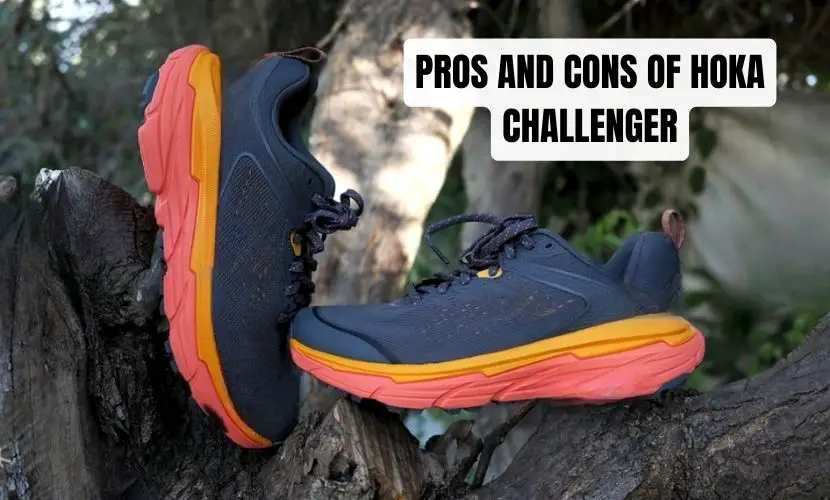
Pros of Hoka Challenger
The Hoka Challenger is a delicate, snug trail running shoe ideal for players prioritizing a more padded ride. The shoe has a broader toe box that permits the toes to splay naturally, giving finer steadiness and balance. The shoe also contains a tongue cushion that features extraordinary comfort and averts the tongue from skidding to the side.
The Hoka Challenger is structured to perform superior on sustained trails and artificial grounds. The shoe has a permeable upper that keeps the feet cool, fresh, and dry, even during long runs. The shoe also comprises a Meta-Rocker midsole that gives an even and stable ride, lessening the influence on the feet and legs.
Cons of Hoka Challenger
One of the key drawbacks of the Hoka Challenger is that it may need to be more adaptable for athletes who prioritize a more unembellished shoe. The shoe has a massive midsole with much padding, but it may feel too chunky for some players.
Another potential disadvantage of the Hoka Challenger is that it may need to function better on steep, sturdy, and loose terrain. The shoe comprises a grippy outsole, but it may need to offer more traction on slippery surfaces.
The Hoka Challenger is a perfect trail running shoe with remarkable cushioning and ease. However, it may not be adaptable for players who prioritize a more minimalistic shoe or those who run on sharp, rugged terrain.
Which is true to size?: Hoka Speedgoat Vs Challenger
Regarding finding the ideal trail running shoe, one of the most efficient factors to contemplate is the fit. After all, if the shoe doesn’t fit appropriately, it won’t offer the necessary aid and may even lead to discomfort or injury. So, which is true to size: Hoka Speedgoat or Challenger?
According to reviews and feedback from players, the Hoka Speedgoat and Challenger incline to run true to size. However, it’s obligatory to mention that everyone has different feet, so what goes for one individual may not work for another. It’s always a perfect idea to test shoes before buying them or ordering from a retailer with a good return policy.
That being said, there are several things to consider concerning the fit of these two shoes. The Speedgoat is popular for having a broader toe box, which can be advantageous for those with extensive feet or who prioritize a spacious fit. Conversely, the Challenger has a more premium fit and a finer choice for those with tighter feet.
Another factor to contemplate is the lacing system. The Speedgoat offers a customary lacing system; however, the Challenger has a more versatile lacing system that permits a more personalized fit.
The Hoka Speedgoat and Challenger are popular for their snug and adaptive fit. While they may vary moderately in the matter of width and lacing system, they incline to run true to size and are a perfect choice for trail runners searching for a dependable shoe.
Hoka Challenger vs. Speedgoat: Which shoes are good for road running?
Regarding road running, the Hoka Challenger and the Hoka Speedgoat have distinct attributes that make one better matched for the task.
The Hoka Challenger 7 is popular for being lighter, faster, and more absorbent, making it a perfect choice for road running. It also comprises a tongue cushion, which can give extra ease for athletes. However, the Challenger functions better on sustained trails and manufactured surfaces, so there may be better options for players who often encounter rugged terrain.
Conversely, the Hoka Speedgoat 5 is more hard-wearing and has a grippier outsole, making it a finer choice for steep, sturdy, and loose terrain. While the Speedgoat can work for road running, it may seem too much shoe for players who run on paved surfaces. Furthermore, the Speedgoat lacks a tongue pad, which may be a drawback for some athletes.
The Challenger may be the finer choice if a runner runs on paved surfaces and values a feathery, more porous shoe. However, if an athlete encounters rugged terrain often and values durability and traction, the Speedgoat may be the superior option.
Hoka Challenger GTX vs. Speedgoat 4
Hoka is a well-admired brand in the running shoe market, and two of their most famous models are the Challenger GTX and Speedgoat 4. Both shoes contain versatile attributes that make them adaptable to different terrain and running styles.
Hoka Challenger GTX
The Hoka Challenger GTX is a feathery and iconic shoe structured for trail runners who desire a shoe that can control diverse terrain. The GTX in the name stands for Gore-Tex, which shows that the shoe is waterproof and absorbent.
The Challenger GTX contains a 5mm drop and a whole-length EVA midsole, which gives remarkable padding and support. The shoe also comprises a hard-wearing outsole with 4mm lugs, offering good grip on damp and dry surfaces. The shoe’s upper is designed of a porous netting material, which aids in maintaining your feet cool, fresh and dry.
Hoka Speedgoat 4
The Hoka Speedgoat 4 is a shoe constructed for runners who desire a shoe that can control the toughest terrain. The shoe is named after Karl Meltzer, who keeps the record for acing the most 100-mile trail races. The shoe contains a 4mm drop and a whole-length EVA midsole, which gives remarkable padding and support.
The Speedgoat 4 comprise a Vibram Megagrip outsole with 5mm lugs, which features outstanding grip on damp and dry surfaces. The shoe’s upper is designed with an absorbent netting material, which aids in keeping your feet cool, fresh and dry. The shoe also contains a fortified toe cap and heel counter, providing additional protection and aid.
Comparison
| Feature | Hoka Challenger GTX | Hoka Speedgoat 4 |
| Weight | 10.8 oz (M), 9.2 oz (W) | 10.8 oz (M), 9.2 oz (W) |
| Drop | 5mm | 4mm |
| Midsole | Full-length EVA | Full-length EVA |
| Outsole | 4mm lugs | 5mm lugs |
| Upper | Waterproof Gore-Tex | Breathable mesh |
| Toe Cap | No | Reinforced |
| Heel Counter | No | Reinforced |
The Hoka Challenger GTX and Speedgoat 4 are perfect shoes for trail running but contain distinct advantages. The Challenger GTX is ideal for athletes who desire a waterproof shoe that can control diverse terrain. The Speedgoat 4 is perfect for players who desire a shoe that can control the toughest terrain and offer remarkable traction.
Hoka Challenger 7 Vs. Speedgoat 5
Regarding selecting between the Hoka Challenger 7 and the Speedgoat 5. Both shoes are structured for trail running, but they have distinct advantages and disadvantages that may make one a finer option for you than the other.
Weight and Drop
One of the most noteworthy differences between these two shoes is their weight. The Challenger 7 is more delicate than the Speedgoat 5, which may make it a superior option for runners who prefer speed and legerity. The Speedgoat 5, on the other side, is moderately massive but has a more hard-wearing construction that can resist rough terrain.
Another dissimilarity to consider is the drop of every shoe. The Speedgoat 5 comprise a 4mm drop, which may be more snug for athletes who prioritize a deeper profile. The Challenger 7 has a 5mm drop, which may be more comfy for players who prioritize a greater heel-to-toe ratio.
Traction and Grip
The Challenger 7 and the Speedgoat 5 have a remarkable grip on the trails, but they use distinct materials to attain this. The Speedgoat 5 offers Vibram Megagrip with Traction Lug, which gives outstanding traction on steep, sturdy, and loose terrain.
The Challenger 7, on the other hand, utilizes a proprietary outsole rubber that features good traction on sustained trails and man-structured surfaces.
Cushioning and Comfort
Both shoes have remarkable padding that can soak up the impact and minimize impact on the joints. The Challenger 7 comprise a tongue cushion that can offer extra ease and support; on the contrary, the Speedgoat 5 does not. However, both shoes contain a similar standard of padding and balance that can make them snug for long runs on the trails.
Note: The Challenger 7 may be a finer option if you prefer speed and legerity. If you require a shoe that can resist rough terrain and offer excellent traction, the Speedgoat 5 may be a superior option. Eventually, both shoes are outstanding options for trail runners and can feature the comfort and aid required for long trail runs.
Conclusion
Selecting between the Hoka Speedgoat and Challenger can be rigid, as both shoes offer versatile attributes and advantages. The Speedgoat is a perfect choice for those who prefer padding and grip on technical terrain; on the contrary, the Challenger is a delicate, faster shoe that functions well on sustained trails and manufactured surfaces.
Eventually, these two shoes will be selected based on the person’s particular requirements and preferences. Following are several major takeaways to contemplate when creating a decision:
- Cushioning: The Speedgoat features more padding than the Challenger, making it a finer option for those who require additional support and impact absorption on elongated runs or technical terrain.
- Traction: The Speedgoat’s Vibram outsole gives outstanding grip on various surfaces; on the contrary, the Challenger’s outsole is finer suited for maintained trails and man-structured surfaces.
- Weight: The Challenger is a more feathery shoe than the Speedgoat, making it a perfect option for those who prefer speed and agility over padding and support.
- Breathability: The Challenger is more absorbent than the Speedgoat, which can be a point to consider for players inclined to overheat or sweat massively.
- Fit: Both shoes feature a snug fit, but the Speedgoat contains a broader toe box than the Challenger, which can be a finer choice for those with extensive feet.
Overall, the Hoka Speedgoat and Challenger are remarkable trail running shoes with versatile advantages and attributes. It’s necessary to consider your requirements and preferences when selecting between them and to test both shoes to detect which one feels perfect for you.
Read more on:


